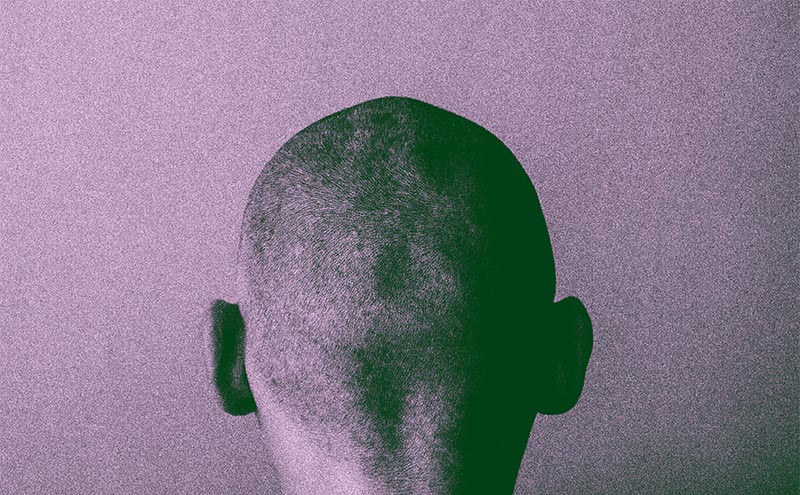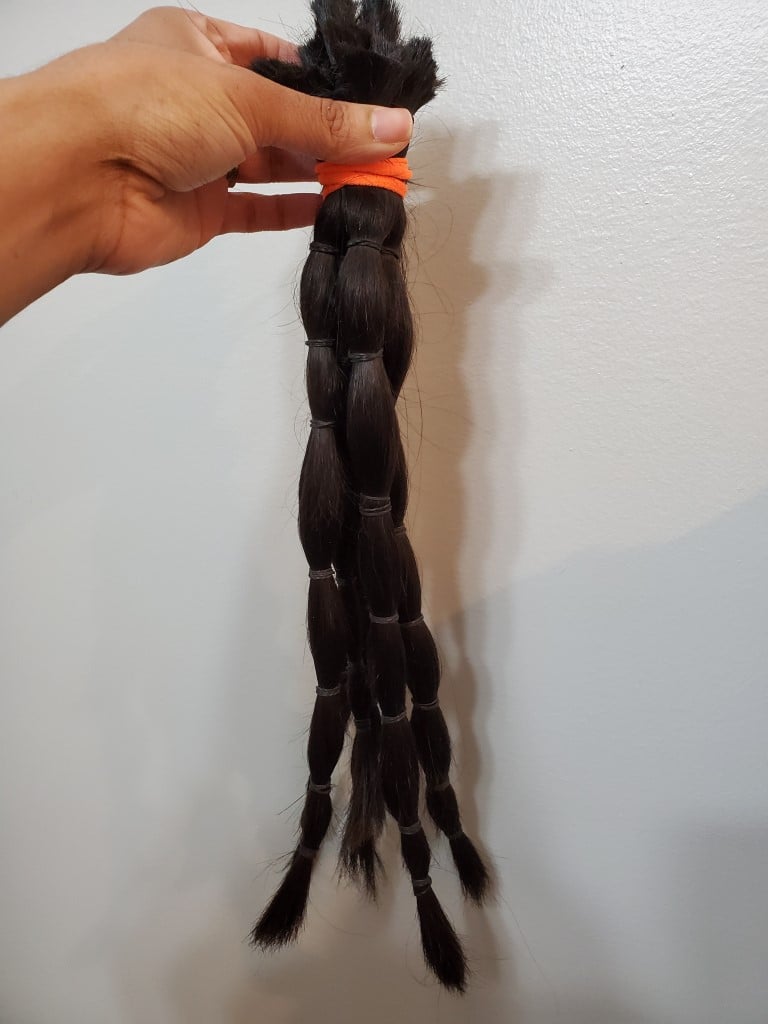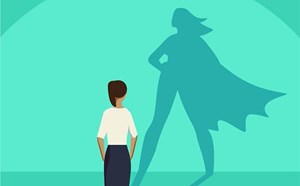
Buzz Cut
For most of my life, my hair has been long with face-framing layers (plus-or-minus a side bang). Every other year or so, I have an “I-need-a-change” moment, and my hair is the martyr. But I am a creature of habit. I say goodbye to 12 to 14 inches, immediately regret it, and then begin my “regrowth” phase. With the exception of these moments, I only get my haircut every 6 months or so, and I ask my hairdresser to trim as little as possible “because I’m growing my hair out.”
Needless to say, my hair has been a large part of my identity. So when my oncologist told me to expect hair loss with my chemo regimen (aka chemotherapy-induced alopecia), I had to get ready. I prepare myself by educating myself. After all, as a physician, I am a declared life-long learner, and it is the only way I know how to process my current situation.
Chemotherapy-induced alopecia can be partial or complete and is most prominent on the scalp, especially at the crown and the front areas of the scalp.1,2 Don’t forget that alopecia is not specific to the scalp and includes loss of eyelashes, eyebrows, axillary hair, and pubic hair. The hair loss is transient and typically reversible. Yet, not surprisingly, it can cause significant distress to patients, specifically, negatively impacting their body image, psychological well-being and quality of life.3-5 It can have such a profound impact that patients may refuse or delay treatments that can otherwise be beneficial.5 Alopecia can be that devastating!
To understand why chemotherapy causes hair loss, you need to understand what chemotherapy does. Chemotherapy attacks rapidly dividing cells in the body, such as cancer cells. Cancer is caused by cells that inappropriately and uncontrollably divide, increasing in number and destroying surrounding tissue. In the normal body, some cells naturally divide more than others, and hair follicles are one of them. Thus, they are more sensitive to the effects of chemotherapy than cells that divide much slower, such as brain cells, or cells that don’t divide at all, such as adipocytes (fat cells).
*Medical Tidbit*
Hair follicles undergo lifelong cycling through the following phases:
Anagen (growth) – 90% of hair follicles are in this stage at any given time.6 Scalp hair grows approximately 0.3mm per day and spends 2 to 6 years in this phase.6,7
Catagen (transformation) – Hair follicle regresses and growth stops. Less than 1% of hair follicles are in this stage at any given time, and scalp hair spends about 3 weeks in this phase.6,7
Telogen (rest) – 10% of hair follicles are in this stage at any given time, and scalp hair can spend 2 to 3 months in this phase.6,7
Exogen (shedding) – The scalp contains approximately 100,000 hairs of which 50 to 150 hairs are shed per day.8
Hairs cycle through these phases asynchronously, meaning we always have hair in different phases of this cycle. So, unlike a snake that sheds all of its skin at one time, we are constantly shedding and growing hair. Of course, many of us—especially, with long hair—don’t need medicine to teach us this. I know my bathroom floor can attest to this.
So, what can be done about chemotherapy-induced hair loss? One option to try to prevent or reduce hair loss is cold caps. Cold caps use the mechanism of scalp hypothermia to vasoconstrict the blood vessels of the scalp and reduce the exposure to chemotherapeutic agents. The FDA currently has approved two automated scalp cooling devices: DigniCap and Paxman. Cooling is started about 30 minutes prior to chemotherapy and continues during the infusion and for 90 minutes to up to 4 hours after the infusion.9,10 Although data on this is limited, it is thought the optimal scalp temperature to cool to is 22°C (71°F), and the automated cooling cap is set to 0°C (32°F) to achieve this.
Two studies which evaluated the efficacy of automated cold caps in patients with breast cancer receiving chemotherapy found that 50 to 66% of patients who used cold caps had significant reduction of alopecia when compared to similar patients who did not use automated cold caps.11,12 This translates to a success rate of 50 to 66%. Now, a few things that are important to consider when interpreting these results.
First, the term “significant” does not refer to the amount of hair loss, but rather is a statistical term that says the results in patients who used cold caps versus those who did not were enough to see a statistical difference. Often, this means that in the real world there is a noticeable difference, but not always. And of course, nothing is guaranteed.
Second, these studies defined success as less than 50% hair loss. So cold caps will not prevent hair loss but rather, theoretically, a patient would lose less hair than if they didn’t use one. Using cold caps, a little more than half of patients will lose less than half of their hair. As with all medical therapies, the decision to pursue a therapy involves a consideration of risks versus benefits. Part of a doctor’s role is to lay out the risks and benefits of the therapy they are recommending to a patient so that they can make an informed decision. For some, it may be worth the time commitment and physical discomfort of cold caps to use them, and for others it may not be. It is a personal decision.
Of course, in the US, financial considerations influence our medical decisions. Scalp cooling costs on average between $1500 and $3000 but can vary depending on the number of chemotherapy cycles.13 At this time, very few insurances offer even partial coverage for cold caps. Hairtostay.org is a national nonprofit organization that is dedicated to making cold caps affordable to cancer patients and provides additional resources about scalp cooling.
Lastly, one of the studies specifically shows that they are much less efficacious (16% success) in patients receiving anthracycline chemotherapy agents.12 Anthracycline is just a category of chemotherapy medication and includes a medication called doxorubicin, which is included in my chemotherapy regimen. So, per discussion with my oncologist, who showed full support either way, and based on the considerations mentioned above, I chose not to pursue cold caps. To note, there are several medications that have been proposed to reduce chemotherapy-induced alopecia, but have been approved by regulatory agencies for use.14
The next step in preparation for me was to cut my hair really short. Patients do this prior to hair loss for a few reasons. Less hair = less mess when it falls out. Seeing yourself with short hair prior to hair loss provides a mental transition to baldness. Some patients also experience a tingling or discomfort sensation at the hair base prior to and during hair loss, which is worse with the pressure and tugging of longer length of hair.
If I had things entirely my way, I would have invited my family members over to watch, celebrate the moment, and treat it like my second mundan. The mundan ceremony is an Indian tradition performed at a child’s first haircut. Family and friends are invited, as well as a priest and, obviously, a barber. The hair is shaved (or buzzed very short) instead of trimmed because it is believed that the hair that a child is born with represents undesirable traits from prior lives. Thus, it is important to completely shave it off to purify the child of these traits and give them a fresh start. There is also a belief that after the mundan, hair grows back thicker and fuller than before, which can be attributed to the increased blood flow to the scalp after hair is shaved off.
Due to quarantining and social distancing, I did not have a party. I also did not have the opportunity to have my hair cut at the salon (although I was pleased to find that many salons offer free services to those getting their hair cut due to hair loss from chemotherapy). Fortunately, my husband occasionally cuts his own hair (and is an amazing person) and buzzed my hair at home.
I ordered a few chemo hats online and purchased a wig from Bravadas wig store prior to buzzing, so I had headwear options. I thought it would be so fun to gather my girlfriends (and some champagne) to go wig shopping, but because of COVID, I did not do this. I have to give major thanks to Bravadas, who met with me online and taught me all about wigs: what to look for, what to expect, how to use them and care for them, etc. They also showed me multiple wigs and shipped one out to me overnight. OVERNIGHT, guys! It fits like a dream and might just be nicer than my own hair. Also due are thanks to my cousins (but really sisters) Rani and Ellyse, who contributed to my extensive wig research prior to buying. Fortunately, unlike cold caps, many insurances cover wigs when provided with a prescription for a “cranial prosthesis.”
I imagined the cut to be way more dramatic than it actually was. My hair now felt like it ruled my life. Countless hours of my life were dedicated to caring and styling it, and what was my face without my hair? I put the chop off as long as possible, citing that I needed my headwear to be delivered before I’d cut my hair and with shipping delays due to COVID, who knew when my stuff would arrive? But when it arrived sooner than expected, I had no legitimate excuses left. One week after my first cycle of chemotherapy, it was time. I was going to have a Zoom call with my cousin, Rani, but then in the moment decided it would be best to minimize the witnesses to me being a crying, blubbery mess.
I sectioned my hair into six sections and wrapped multiple small elastics throughout each section to keep the locks secure. (Two more sections and I would have officially had a hair octopus on my head.) Picture 1990s Coolio, but longer hair. Then I snipped each one at the base and threw the hair into a Ziploc bag. I haven’t decided yet whether I will get a wig made from it or donate it. Then I sat on my “bye-bye, hair” throne: our kitchen step stool, which was placed on a cut-open garbage bag that covered the floor.
Bzzz, bzzzzzz, bzzzzzzz. Goodbye, hair.
I didn’t feel lighter. I didn’t feel relieved. I didn’t feel anxious. I honestly didn’t feel any different. I interpreted this to be good. After all, I was still me. I still don’t feel any different. But I did realize that in losing my hair, I gained something. Some time. I was regaining the time I usually spend washing, blow drying, straightening, and curling my hair. It’s was part of my self-care routine, but it’s nice to have time to dedicate something else.

After the buzz, I video chatted with my three-year-old daughter, Ananya, who was with my parents. I had been preparing her for this cut almost as severely as I had been preparing myself. I didn’t know how she’d react, and I just didn’t want it to be a bad reaction, whatever that is. Of course, being her jolly self, she pointed and laughed at me and said, “Mommy has a haircut like Daddy and Nana!” (“Nana” is my dad.) There it was. If those who I love the most can handle this with laughter, so can I.
Since then, I have worn neither my hats nor my wig. I’ve actually been sporting the buzzed look pretty comfortably. Throughout my life, I have tried to wear many different hats (literally speaking), but have never developed a liking for the look on me. I know they are there if and when I choose to use them. They are a costly, but effective, security blanket.

Well, I am just wrapping up my second cycle of chemotherapy and expect to return in two weeks somewhat bald. Maybe I’ll be donning a hat or my wig—or maybe I won’t!
References
- Chon SY, Champion RW, Geddes ER, Rashid RM. Chemotherapy-induced alopecia. J Am Acad Dermatol 2012; 67:e37.
- Yun SJ, Kim SJ. Hair loss pattern due to chemotherapy-induced anagen effluvium: a cross-sectional observation. Dermatology 2007; 215:36.
- Choi EK, Kim IR, Chang O, et al. Impact of chemotherapy-induced alopecia distress on body image, psychosocial well-being, and depression in breast cancer patients. Psychooncology 2014; 23:1103.
- Lemieux J, Maunsell E, Provencher L. Chemotherapy-induced alopecia and effects on quality of life among women with breast cancer: a literature review. Psychooncology 2008; 17:317.
- Hesketh PJ, Batchelor D, Golant M, et al. Chemotherapy-induced alopecia: psychosocial impact and therapeutic approaches. Support Care Cancer 2004; 12:543.
- Price VH. Treatment of hair loss. N Engl J Med 1999; 341:964.
- Breitkopf T, Leung G, Yu M, et al. The basic science of hair biology: what are the causal mechanisms for the disordered hair follicle? Dermatol Clin 2013; 31:1.
- Paus R, Cotsarelis G. The biology of hair follicles. N Engl J Med 1999; 341:491.
- Symonds RP, McCormick CV, Maxted KJ. Adriamycin alopecia prevented by cold air scalp cooling. Am J Clin Oncol 1986; 9:454.
- van den Hurk CJ, Breed WP, Nortier JW. Short post-infusion scalp cooling time in the prevention of docetaxel-induced alopecia. Support Care Cancer 2012; 20:3255.
- Rugo HS, Klein P, Melin SA, et al. Association Between Use of a Scalp Cooling Device and Alopecia After Chemotherapy for Breast Cancer. JAMA 2017; 317:606.
- Nangia J, Wang T, Osborne C, et al. Effect of a Scalp Cooling Device on Alopecia in Women Undergoing Chemotherapy for Breast Cancer: The SCALP Randomized Clinical Trial. JAMA 2017; 317:596.
- Hershman DL. Scalp Cooling to Prevent Chemotherapy-Induced Alopecia: The Time Has Come. JAMA 2017; 317:587.
- Rugo HD & Lacouture M. Alopecia related to systemic cancer therapy. UpToDate, Post, TW (Ed), UpToDate, Waltham, MA, 2014.
Kavita Jackson, MD



